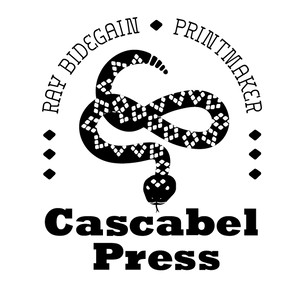As I look back at my time in photography, I see that, first in college, and later on my own, I mostly studied how photographs were made. I felt like I would go out and point my camera at things that would work well with said process and that fit into an expected mold. I truly loved the work I was making and things went well for me.
I chose my heroes: Irving Penn, Richard Avedon, and Ansel Adams. Edward Weston and a few fashion photographs rounded out the mix. From Ansel, I learned the zone system. This was all about how to go out with my camera and come home with film and a notebook full of notes promising to render every tone as it had existed. From Penn, I strived for the simplicity that I found so haunting in his work, and of course, his platinum prints. I would spend 20 years in my studio making platinum prints, all contact prints from large-format negatives processed to work perfectly with this process I loved.
Later when I began printmaking, I wanted my journey to be less driven by a process with such specific end results. So I made some choices. I know far less about what printmaking is “ supposed to be.” I don’t really know the rules. The photogravure print is not without process. I am not suggesting that. I had to learn how to make the plates and prints, but I went about it differently. I read about the basics and materials, and then I experimented and adjusted, striving to let these prints be my interpretation of what I wanted in the final object. Every tone is likely not represented like a zone system silver or platinum print of my past or an inkjet print of today. I have no idea really because I no longer print grey scales and read them with a densitometer. Instead, I print pictures, lots and lots of pictures, each one a bit different, or even a lot different, than the one before. I do this intentionally and empirically. By this, I mean I make plates and prints and then adjust either or both to get the picture I am thinking about. Are they perfect photographs? Probably not, but they are exactly what I want and straight from my heart.
Students who come to study with me learn this same way. I help them with basics, and demonstrate the needed skills.. After that I strive to have them do all the steps themselves, and encourage them to experiment and make interpretations that feel good to them. At the end of the workshop they have a stack of successful prints and a path to make more at home. Art making at its best.
All of this adds up to me feeling like I am making work that is more personal, driven by a finished object that I made on my terms and less controlled by the process or the equipment I am using . I find that I am paying more attention to how I feel about what I point my camera towards and less about all of the photographs I have seen or made in the past. And for sure less about how it “will come out”.
Letting go a bit has been a wonderful twist in this journey of mine. I have a couple of dear friends who have known this stuff for years. I highly recommend trying it. I would also like to hear about how you came to make photographs and how it has changed for you over the years.
Now Ray, what about this picture I see at the top of the page? You may be asking.
I made this soft ground copper plate etching by drawing from one of my pictures. I etched the plate and printed it on my Takach press.
- Ray, can you draw ? Everyone can draw, but NO is the answer.
- You did it, and are showing us anyway? Yes.
- How does it feel? Dreamy and scary at the same time.
- Have you etched copper plates before? Nope.
- Are you quitting photography? No way, but I am wanting to teach myself to draw.
Be well,
Ray










